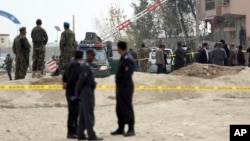Afghanistan's government continues to lose ground to the Taliban, a Pentagon watchdog says, noting Kabul now controls or influences just 56 percent of the country's districts.
That is the lowest level recorded since the Special Inspector General for Afghanistan Reconstruction, or SIGAR, began tracking district control in November 2015.
The figures suggest President Donald Trump's strategy for Afghanistan, unveiled 14 months ago, is not resolving the U.S. stalemate with the Taliban.
The Taliban now controls or influences 12 percent of Afghanistan's districts, with 32 percent of the districts controlled by neither the Afghan government nor the insurgents.
The situation looks slightly better when viewed through population control: 65 percent of Afghans live in areas controlled by Kabul, according to SIGAR.
U.S. and Taliban officials have been engaging in preliminary talks aimed at resolving the 17-year-old conflict. But it's not clear how much progress has resulted from those talks, and the violence has not stopped.
The U.S.-led coalition continues to drop an unprecedented number of bombs. If trends continue, 2018 likely will see the heaviest U.S.-led aerial bombing campaign since the start of the war.
Last month, Scott Miller, the top U.S. general in Afghanistan, survived a Taliban attack that killed Abdul Raziq, a top police general in Kandahar.
Afghan forces have been the hardest hit, taking on so many casualties that U.S. and Afghan officials decided last year to stop releasing the number of Afghan forces killed and wounded.
Though that data is still withheld, U.S. officials told SIGAR that the average number of Afghan casualties from May 1 to October 1 2018 "is the greatest it has ever been during like periods."








